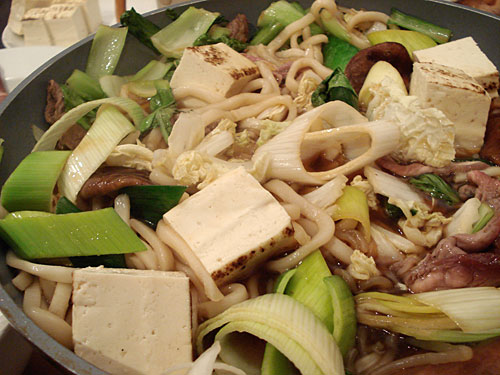
Sukiyaki (すき焼き)is a Japanese word that is widely known outside of Japan, but very few people have actually had the real thing unless they've been invited to a Japanese person's home for dinner - or gone to a traditional inn or ryoutei (high end traditional Japanese restaurant) where it is cooked for you at the table. This is because, like tori nabe, this is really another nabe that is cooked at the table, at home, rather than eaten at a restaurant. You may encounter 'sukiyaki' on some restaurant menus, but if it's been cooked in advance in the kitchen, it really isn't sukiyaki. (I'm not sure why there are dedicated shabu-shabu restaurants but no sukiyaki restaurants, but I think it's because sukiyaki is so strongly associated with home cooking.)
Unlike tori nabe, sukiyaki is not inexpensive, since you need top grade steak-quality meat. If you have access to a Japanese grocery store or a butcher that is familiar with the 'sukiyaki' cut, you can buy ready-cut meat there. (In New York, I used to get sukiyaki meat from Schaller and Weber on the Upper East Side). If you can't get sukiyaki meat, get a piece of sirloin with a good amount of marbling and a thick piece of fat attached. Allow for about 100 grams / 3 1/2 ounces of meat per person. You do not need to use wagyuu or Kobe beef - that would be overkill. In Japan, sukiyaki is the quintessential gochisou (御馳走) - feast or treat, because good beef is the most expensive kind of meat. It's what you have for a special occasion, or just after payday.
Sukiyaki can be enjoyed at any time of the year, but any kind of nabe seems to be best suited to the winter, when the family can gather around the dining table helping themselves from a fragant, steaming pan of food.
There are two basic methods of making sukiyaki: Kanto, or Tokyo-area style, and Kansai, or Kyoto/Osaka area style. Since I'm from the Tokyo area I'll show you how to do the Tokyo style, with a recipe for the Kyoto method below.
Recipe: Classic Kanto Style Sukiyaki
Feeds 4 adults
- 1 lb / 450g well marbled sirloin or similar, with a chunk of fat on the outside; OR about 1 lb of sukiyaki beef with a small chunk of beef fat
- 1 block of firm tofu or yakidofu (firm tofu that has been lightly grilled on the outside, available at Japanese grocery stores), cut into chunks (allow for 2 chunks per person)
- 1 small or 1/2 large chinese/napa cabbage, cut up into chunks
- a bunch of green leafy vegetables - I used pak choy here (traditional green is shungiku; use what you have)
- 4 large or 8 small/medium raw shiitake mushrooms, stems cut off (you can use portobello mushrooms instead, sliced - 1-2 big ones)
- The white of 1 leek, sliced
- 2-3 packs of fresh or frozen udon noodles
- 1 pack of rinsed and blanched shirataki noodles
For the sauce, called warishita (割り下)
- 1 1/2 cups water
- 1/2 cup dark soy sauce
- 1/4 cup sake
- 1/4 cup mirin
- 1/4 cup sugar
Optional:
- 4 raw eggs, to serve as the dipping sauce
Equipment:
- A tabletop burner (see the tori nabe article)
- A sukiyaki pot (a flat cast iron pot), or a large sauté pan or frying pan with fairly high sides so that you can pile in the vegetables and so on
- Long chopsticks or a long fork or tongs
- Smallish bowls for serving, one per person. Breakfast cereal sized bowls are good.
If you got the hunk of steak meat, put it in the freezer until it's half-frozen and stiff. This makes it easier to slice. Cut the outer fat off and reserve. Slice the rest against the grain into thin slices. Arrange neatly on a plate.
Cut up the vegetables and put into bowls, ready to go. Take the udon noodles out of their packets Rinse and briefly blanch the shirataki noodles. (The amount of udon noodles depends on whether you will be having rice with the meal or not. If yes, then you only need 1 or 2 packs of udon; if not, then go for more udon.)
Mix all the liquid ingredients for the warishita together and put into a jug or something. Have the sugar ready. (Note: my stepfather just pours each ingredient directly into the pot, but pre-measuring things will probably be easier for beginners)
Set out the burner, the pan, the bowls and utensils We're ready to go now!
Heat up the pan on the burner, with the reserved piece or pieces of beef fat. Rub the fat around the pan a bit until it's melting.
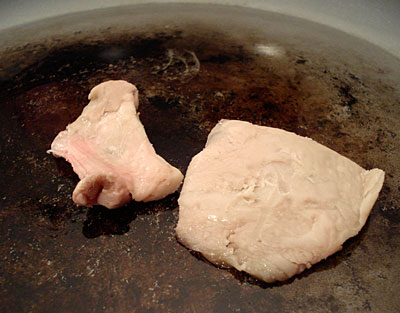
Once there's a good film of melted fat all around the pan, pour in the sugar and mix around a bit. Then add the liquid ingredients. If the pan is hot enough it should boil up almost immediately.

Let it simmer for a bit to evaporate the alcohol in the sake and mirin. Then, add around a quarter or so of the beef slices. (Take out the beef fat pieces at this time.)
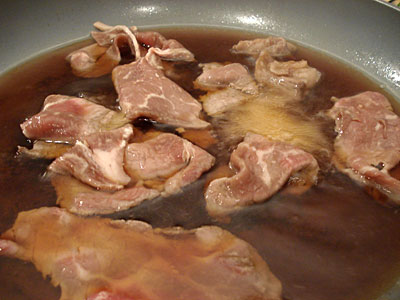
These first beef slices plus the beef fat provide the base flavor for sukiyaki, together with the warishita ingredients. Once the beef is cooking, you can start adding the other ingredients. Start with the vegetables and shiitake mushrooms, then add the tofu and shirataki. Remember to scoop out the beef slices and eat them!
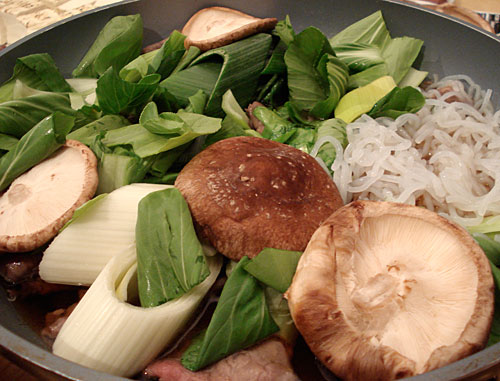
Keep eating the vegetables and things as they cook. About halfway through, add the udon (if you add it earlier it can get a bit overcooked, though it will still be very tasty). Now, this is optional, but the standard dipping sauce for sukiyaki is a raw beaten egg. But only do this if you are sure of the quality of your eggs - they should be farm fresh, maybe date-stamped, or pasteurized.
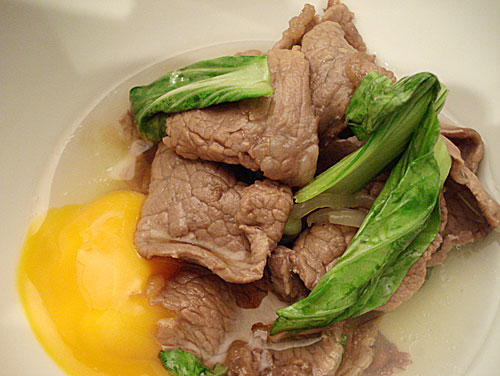
Keep on taking out cooked stuff and putting more stuff in to cook. If the pan gets too dry, just add a bit of water and maybe a bit more soy sauce. Near the end of the proceedings, this is how the pan looks - everything a mellow light brown, having slurped up the goodness of that sauce.
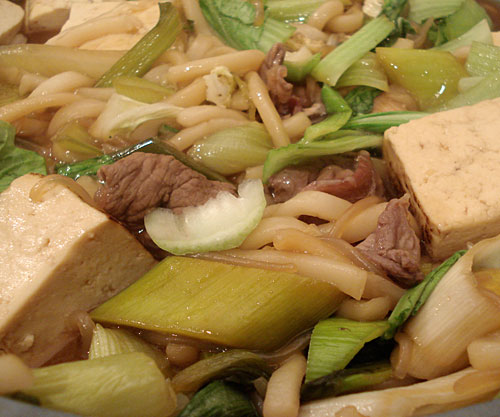
Leftover sukiyaki, mixed with some egg and cooked, is delicious over hot rice. (You could also simmer it in a pan until the liquid is almost evaporated and use it in a bento the next day.)
Variant: Kansai Style Sukiyaki
With Kansai style, you pan fry all the meat before adding everything else. Melt the beef fat in the pan as per the Kanto style, then add the meat slices. Add the sugar to the pan and let it coat the meat. Then add the warishita, and proceed as for the Kanto style. I prefer the Kanto style because I think the meat can get a bit tough with Kansai style - and besides, that's the method I grew up with. In Kansai style, you often add fu to the pan (reconstitute the fu in water first, squeeze out well, and add to the sukiyaki pot).
Extra: The Sukiyaki Song, which has nothing to do with sukiyaki
In 1963, a Japanese song named The Sukiyaki Song became a no. 1 hit in the U.S., even though it was sung in Japanese by a singer unknown to the west, called Kyu Sakamoto (坂本九). It was called Sukiyaki because some record executive decided that that word sounded appropriately Japanese to an American audience. As the Wikipedia entry says, the original lyrics have nothing to do with sukiyaki - it's actually a rather sad song about someone walking alone at night with a broken heart. And the original title is 上を向いて歩こう (Ue o muite arukou) - Let's Walk Looking Upwards. Here are the original lyrics, with my translation:
上を向いて 歩こうよ Let's walk looking upwards
涙がこぼれないように So that (my) tears don't fall
思い出す 春の日 (I) remember that spring day (with you)
一人ぽっちの夜 A lonely night
上を向いて歩こう Let's walk looking upwards
にじんだ 星をかぞえて Counting the blurry stars in the sky
思い出す 夏の日 (I) remember the summer day (with you)
一人ぽっちの夜 A lonely night
幸せは 雲の上に Happiness is above the clouds
幸せは 空の上に Happiness is above the sky
上を向いて 歩こうよ Let's walk looking upwards
涙がこぼれないように So that (my) tears don't fall
泣きながら 歩く (I) walk while crying
一人ぽっちの夜 A lonely night
思い出す秋の日 (I) remember that autumn day (with you)
一人ぽっちの夜 A lonely night
悲しみは 星のかげに Sadness is in the shadows of the stars
悲しみは 月のかげに Sadness is in the shadow of the moon
上を向いて 歩こうよ Let's walk looking upwards
涙がこぼれないように So that (my) tears don't fall
泣きながら 歩く (I) walk while crying
一人ぽっちの夜 A lonely night
一人ぽっちの夜 A lonely night (I am alone tonight)
Here is the original singer, Kyu Sakamoto, singing Ue o muite arukou when he was 22 years old in 1963:
Kyu Sakamoto, known affectionately as Kyu-chan, was very popular throughout his lifetime in Japan as an all around entertainer. I was too young to know him during his singing heyday in the '60s, and when I did become cognizant of him I rather disliked him because he was known as a do-gooder and self-promoter (he did a lot of charity work and such, much of it well publicized, which was not really that common for Japanese celebrities). Besides, his singing was considered awfully old fashioned by us kids.
He died tragically in the Japan Airlines Flight 123 crash at the age of 44. Since then, I've come to appreciate his unique singing style as well as his persona a lot more. His best songs were those with upbeat music and rather sad or wistful lyrics. Here's another one of his big hits in Japan, 見上げてごらん 夜の星を (Miagete goran yoru no hoshi o : Look Up At The Stars In the Sky):
I think he was so popular, especially in the 1960s, because the combination of youthful bravado and cheerfulness tinged with a sadness, even tragedy that he was able to convey, perfectly fit the mood of the times, when Japan was growing as a nation at an alarming pace while experiencing the side effects of such growth such as environmental disasters, stress and alienation. I'm not sure if he'd still be a hit in today's more cynical Japan though.
Type: recipe Filed under: japaneseparty foodwinterfavoritesbeefwashokunabe





















